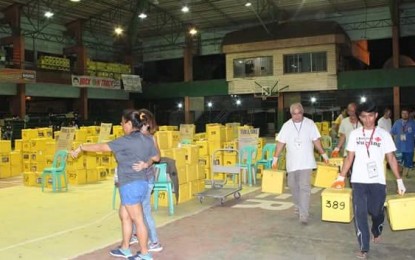
(File photo)
MANILA – Younger Filipino voters, particularly those born during the 1972-1981 martial law years and beyond, may be interested to know that around this time in December 1985, the political camps of then President Ferdinand E. Marcos and the opposition parties were busy preparing for the snap presidential and vice presidential election set on Feb. 7, 1986.
The result of that special election can be considered as the most controversial and confusing among the previous polls held since the birth of the Philippine Commonwealth government in November 1935.
Marcos, who was then in his 20th year of a prolonged presidency since Dec. 30, 1965, first announced the holding of the special polls in an American television interview on Nov. 3, 1985. It was also broadcast by the Philippine government TV station Channel 4, then located at the present site of ABS-CBN radio-TV station along Sgt. Esguerra Avenue in Quezon City.
Press reports at that time said Marcos consented to the holding of the snap polls to prove to the world that he still enjoyed the mandate of the Filipino people. He originally set the election on Jan. 17, 1986, the fifth anniversary of his lifting martial law five years before, or in 1981.
Caught by surprise, the opposition leaders said they needed more time to prepare, unify and choose a possible common candidate to run against that of the ruling Kilusang Bagong Lipunan or KBL.
Marcos agreed to give the opposition the needed time, while the then Regular Batasan Pambansa or National Assembly passed Batas Pambansa Blg. 883 or an "Act calling for a special election for president and vice president, providing for the manner of holding thereof, and appropriating funds therefor, and for other purposes."
The law was signed by Marcos on Dec. 3, 1985. It set the special polls for Feb. 7, 1986 with a total budget of PHP200 million out of the appropriations for special activities fund authorized in the Calendar Year 1985 and Calendar Year 1986 General Appropriations Acts.
Except for the country's top two elective positions, there were no other candidates in the special polls.
The KBL fielded Marcos as its presidential candidate with then Assemblyman and former Senate President Arturo M. Tolentino as his running mate.
The opposition parties, on the other hand, had a common candidate for the presidency, Mrs. Corazon C. Aquino, widow of assassinated former opposition Senator Benigno "Ninoy" Aquino Jr. Her running mate was then Assemblyman and former Senator Salvador H. Laurel of the United Nationalist Democratic Organization or UNIDO.
The special election was particularly important. For one thing, it served as a step in restoring the missing system of presidential succession because of the absence of a vice president's position under the 1973 Constitution which provided for a parliamentary system of government for the Philippines.
Under the parliamentary government, the executive power is exercised by the prime minister as the head of government. He is assisted by the Cabinet composed of the heads of ministries as provided by law. There is no need for a Commission on Appointments to confirm such appointments, like in the 1935 and 1987 Constitutions.
Both the prime minister and the president are elected by members of the National Assembly from among themselves. Once elected, the president, who serves only as the symbolic head of state, ceases to be a member of the assembly and of any political party.
In case of permanent disability, death, removal from office, or resignation of the president, the speaker of the national assembly shall act as president until a successor has been elected for the unexpired portion of the term of the president.
According to the book "Philippine History and Government" by noted historian Dr. Gregorio F. Zaide and his daughter, Dr. Sonia M. Zaide, the 1986 snap presidential and vice presidential polls was one of the most historic, confusing and controversial elections in Philippine history.
For one thing, a woman candidate ran for the first time and won as president. For another thing, both sides -- Marcos and Mrs. Aquino -- claimed they won and took their oath of office.
The book said: "The private and unofficial count by volunteer watchdogs (led by the National Movement for Free Elections or Namfrel) showed that Mrs. Aquino and Mr. Laurel won. But the official government count showed that President Marcos and Mr. Tolentino had won. The Batasan proclaimed Marcos and Tolentino as the winners. But during their inauguration at Malacañan Palace, the Filipino people were already in a revolution."
In the morning of Feb. 25, 1986, the last day of the four-day "People Power" revolt that forced the Marcos family out of Malacañang, Mrs. Aquino took her oath as new president of the Philippines at ceremonies held at Club Filipino in Greenhills, San Juan (now a city). She also became the country's first lady head of state.
After appointing a new Cabinet and announcing the full restoration of democracy in the country, Aquino proclaimed a temporary "Freedom Constitution" on March 25, 1986. She also appointed a 48-member Constitutional Commission (ConCom) to make a new Constitution in place of the 1973 charter.
The present Constitution was ratified by the Filipino voters in a plebiscite held on Feb. 2, 1987.
On May 11, 1987, the people elected 24 new senators and about 200 congressmen for the newly-restored Congress.
The election of local officials such as provincial governors, vice governors and board members, as well as city and town mayors, vice mayors and councilors followed on Jan. 18, 1988. New barangay officials were also elected on March 28, 1989.
On May 11, 1992, the Philippines held its first general elections under the 1987 Constitution with the restored position of vice president. Those proclaimed winners were President Fidel V. Ramos and Vice President Joseph Estrada. (PNA)
